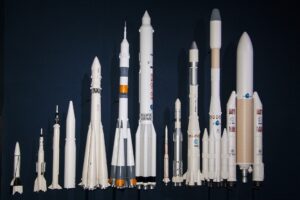 A rocket is a vehicle that uses jet propulsion to accelerate without using the surrounding air. It is a missile or vehicle propelled by the combustion of a fuel and a contained oxygen supply. The forward thrust of a rocket results when exhaust products are ejected from the tail.
A rocket is a vehicle that uses jet propulsion to accelerate without using the surrounding air. It is a missile or vehicle propelled by the combustion of a fuel and a contained oxygen supply. The forward thrust of a rocket results when exhaust products are ejected from the tail.
Rocket engines work entirely from propellant carried within the vehicle; therefore a rocket can fly in the vacuum of space. Rockets work more efficiently in a vacuum and incur a loss of thrust due to the opposing pressure of the atmosphere.
A rocket needs to accelerate to about 17,500 miles per hour to get into Low Earth Orbit. If it is travelling to the Moon, it needs to go even faster, at around 25,000 miles per hour.
Multistage rockets are capable of attaining escape velocity from Earth, and therefore can achieve unlimited maximum altitude. Compared with airbreathing engines, rockets are lightweight and powerful, and capable of generating large accelerations.
To control their flight, rockets rely on momentum, airfoils, auxiliary reaction engines, gimballed thrust, momentum wheels, deflection of the exhaust stream, propellant flow, spin, or gravity.
Rockets for military and recreational uses date back to at least 13th-century China. Significant scientific, interplanetary, and industrial use did not occur until the 20th century, when rocketry was the enabling technology for the Space Age, including setting foot on the Moon.
Rockets are now used for fireworks, missiles and other weaponry, ejection seats, launch vehicles for artificial satellites, human spaceflight, and space exploration.
Here is a simple explanation: Rocket Science: How Rockets Work – A Short and Basic Explanation
© Copyright 2025 Hinterland Limited.
Contacting us is easy, simply complete the form below.
Standard delivery ships in 2-4 working days.
Please allow up to 4 weeks for international orders to arrive (we are working very hard to reduce this time).
FREE on all orders over £25.00;
£3.95 for orders under £25.00;